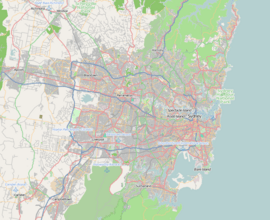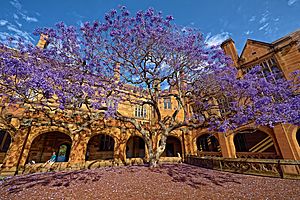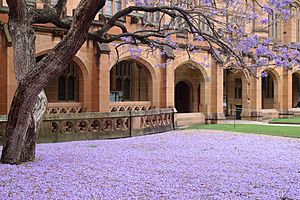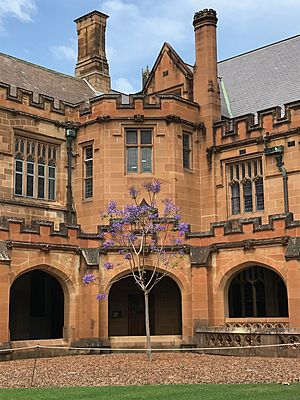Jacaranda, University of Sydney facts for kids
Quick facts for kids Jacaranda, University of Sydney |
|
|---|---|
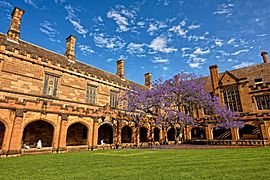
The jacaranda in the main quadrangle at the University of Sydney (2014)
|
|
| Species | Jacaranda mimosifolia |
| Location | University of Sydney Quadrangle, Camperdown campus of The University of Sydney, Parramatta Road, Sydney, New South Wales, Australia |
| Coordinates | 33°53′10″S 151°11′21″E / 33.88611°S 151.18917°E |
| Diameter | 18 metres (59 ft) (canopy, 2016 felled tree) |
| Date seeded |
|
| Date felled | 28 October 2016 |
| Custodian | The University of Sydney |
The jacaranda was a very important Jacaranda mimosifolia tree. It stood in a special spot at the University of Sydney's main quadrangle. Now, a new tree, which is an exact copy (a clone) of the old one, grows in the same place.
The first jacaranda tree was planted in 1928 by Professor Eben Gowrie Waterhouse. It was replaced a few times in the 1930s. The tree bloomed in late spring, right when students had their exams. Because of this, it became famous for being linked to exam time at the university. The original tree was a beautiful background for many events. It was even listed as a special tree by the City of Sydney. On October 28, 2016, the old tree died and fell down. It was about 77 to 85 years old. On July 20, 2017, the University announced that they would replace the jacaranda with a genetically identical clone. They also planted a native Illawarra flame tree in a different corner of the quadrangle.
Contents
The First Jacaranda Tree
How it was Planted
The jacaranda tree was planted in a corner of the quadrangle. This was near where Philosophy classes used to be taught. Professor Eben Gowrie Waterhouse planted it. He was a professor who taught German and studied different types of books. He was also an expert on camellia flowers.
Professor Waterhouse loved gardening and designing outdoor spaces. This helped shape how the university's gardens looked. People say he changed the main quadrangle, where the jacaranda grew, from "an unsightly mess into a dignified area." Waterhouse continued to help with planting trees and making the university look beautiful for many years. He also helped with tree planting in other cities. In 1936, he said that making cities beautiful was "among the finest forms of community service." He believed that planting trees and taking care of them were both important. In 1966, he received a gold medal from the Royal Horticultural Society in London.
Stories were told for many years about how hard it was to get the tree to grow. Some people blamed students for pulling out young trees. University members were upset and passed "motions deploring the actions of 'irresponsible vandals'." Newspapers even reported about vandalism to the jacaranda as late as 1939. Another idea was that staff members stole young trees for their own gardens.
Eventually, the tree grew successfully. Over its life, the jacaranda's canopy (the leafy part) grew to be 18 meters wide. It became both "grand" and "iconic," meaning it was very impressive and well-known.
Life of the Tree
The University of Sydney's jacaranda tree was a backdrop for many public and private events. These included graduation ceremonies and weddings held in the quadrangle. Mark Scott said it was "the most famous tree in education." The university's grounds manager said, "I don't think the quadrangle would be the space it is without that tree."
Many people loved the tree. This was true even though it was linked to exam time in November. That's when jacaranda trees all over Sydney bloom. A popular belief was that if a student had not started studying by the time the purple flowers appeared, they would fail their exams.
In 2005, the jacaranda was added to the list of important trees in the City of Sydney. It was called "one of Sydney's best known significant trees." People knew it as "a living asset." In 2012, the city's main tree expert put it in the Top 10 of this list. Trees on the list are chosen for their "historical, cultural, social, ecological or outstanding visual and aesthetic appeal." Other types of trees on the list near the university include Moreton Bay figs in Alexandria Park and Observatory Hill. There are also Brush box trees in Glebe, Washington palms in Farrer Place, Plane trees on Bourke Street, and Dragon's blood trees in Cook and Phillip Park.
The Tree's Death
In 2016, the tree died. It was about 77 to 85 years old. It might have died from a fungus called ganoderma. The tree fell over on October 28. It was cut up and removed the next day. The university sent out a message to students. It reminded them that the tree had started to bloom and wished them "all well for their final weeks of study for 2016."
The Current Jacaranda Tree
Getting Ready for a New Tree
In 2014, the university was told that the original tree was getting old and might die soon. The university knew how important the tree was. So, they took small pieces (cuttings) from it. They grew three "emergency" copies of the tree. These copies, called clones, would allow them to replace the old tree with a new one that was exactly the same.
Planting the New Tree
In July 2017, the cloned tree was planted. This new tree is a graft from the old tree. This means a part of the old tree was joined to the roots of another jacaranda. The new tree grew well. By November 2019, it was blooming with purple flowers.
The university also planted a native flame tree next to the new jacaranda. They did this to honor the Gadigal people. The university is located on their traditional lands.


